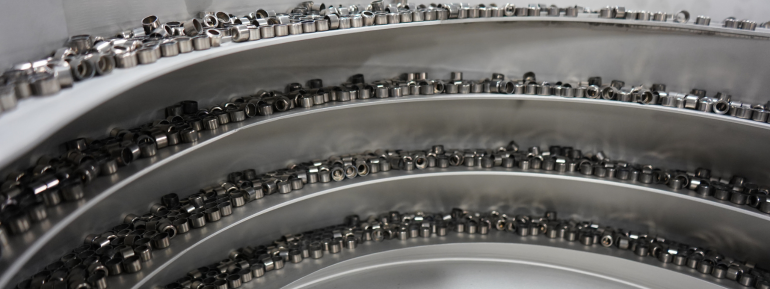Unless you’re in the business, keeping track of the many varieties of parts feeder systems can be daunting. And if you currently use feeder systems in your business, understanding the difference among the options may leave you feeling even more perplexed.

To help add clarity, here are the six different types of parts feeder systems you need to know, along with their primary components and functions:
1. A centrifugal feeder’s key features may consist of the following:
- A standard tooling unit that runs on the inside of the system and is built for a specific part or project
- A modular feeder that is built to be adaptable for various types of parts and can be changed over easily for different parts in the same family
- A scallop feeder for parts with longer height to width ratios
- A puck feeder when parts don’t want to stand on their own but adds another level of tooling
- Heavy duty construction for metal or extremely heavy parts
2. A vibratory feeder’s key features may include:
- An inside tool that establishes all the parts selection done inside the basic bowl
- An outside tool for when parts selection is done with tooling on the outside of the bowl
- Orientation features: tooling that effects parts to put them in proper orientation
- Selectors: A portion of the tooling that selects off all parts but the correct one

3. A linear feeder may feature:
- A vibratory inline track that uses vibration to move parts
- A conveyor, which moves parts using a belt system
- An AirVeyor, which uses air from a regenerative blower – not compressed air – to move parts
- A gravity, or down angle track, which is a stationary track that uses gravity to move parts
4. A flex feeder includes the following:
- A system that can accommodate any part and uses vision-guided robots to identify and select parts for assembly
- Ability to feed parts in a loop, but not oriented; a series of conveyors and trays feed into the conveyor repeatedly
- Robots that pick parts they want off conveyors allowing the rest to recirculate
5. A step feeder is useful for:
- Feeding small cylindrical and spherical parts
- Effective for automatic feeding and presentation of parts for some automatic assembly
- Very part specific, only select parts can be fed in step feeders
6. An elevator feeder has one primary use, which is:
- To feed simple parts at various rates
Still have questions about the different types of parts feeder systems? Contact us today to learn more about which solution is right for your organization.
October 12, 2016
Related Topics: